Taylor Sheridan's New $1B Deal, Explained
Why TV's biggest rainmaker left Paramount for NBCUniversal.
Thanks for subscribing to SatPost.
Today, we will talk about why Taylor “I frickin’ wrote Sicario as my first script” Sheridan is leaving Paramount for NBCUniversal in a $1B deal.
Also this week:
The $20K Neo Human Robot (Is Hilarious)
OpenAI Headed For $1T IPO?
…and them wild posts (including updates on the Louvre Heist)
This issue of SatPost is brought to you by Bearly AI
Are you looking for a no-logging, encrypted and anonymized AI chat tool?
Then try the Bearly AI research app, which provides an easy-to-use UX for the newest models from OpenAI, Anthropic, xAI, DeepSeek, Gemini and more.
While some AI providers keep chat logs indefinitely even after a user deletes them...Bearly AI has a default no-logging policy and user chats are encrypted while requests to LLM providers are completely anonymized.
Try one month FREE of the Pro Plan using the code BEARLY1.
The biggest rainmaker in TV right now is Taylor Sheridan.
Which is why Hollywood has been in a tizzy over the news that Sheridan is leaving Paramount for NBCUniversal in a 5-year deal potentially worth $1B. He can start making films for Universal Pictures next year but will finish out his Paramount TV contract through 2028, then throw some heaters for NBC and its Peacock streaming service.
Sheridan’s Paramount TV run has been very lucrative and here are some numbers via Bloomberg:
Since its debut in 2018, Yellowstone has generated revenue of $2.9B and profit of ~$700m (with another $450m spent on downloads and — dafoook??? — DVDs) while becoming the largest scripted show on TV in the latter half of its 5-season run.
The Paramount+ streaming platform launched in 2021 by sucking on the teet Sheridan’s creativity including banger shows such as 1883, Mayor of Kingstown, Tulsa King and 1923. Sheridan has since added Lioness and
Billy Bob Thornton’s iconic facial hairLandman to the mix, helping to drive Paramount+ to over 75 million subscribers. His new ideas were particularly important because Paramount licensed the Yellowstone catalogue to NBC’s Peacock streaming service in a generational boneheaded streaming mistake. While Sheridan isn’t responsible for every single one of those subs, I can assure you no one was signing up on the streaming app for Season 1 of I Hate My Teenage Daughter.Since the start of 2022, TV shows by Taylor Sheridan have totalled over 1.3B streaming hours (more than other A-list showrunners such as Shonda Rhimes, Bill Lawrence or Ryan Murphy).
The wildest part of Sheridan’s run isn’t even a number. It is the fact that he has basically been writing these shows solo in a one-room isolated cabin in Wyoming while everyone else has a massive writer’s room (although Sheridan has started sharing more story responsibility to others on Landman and Tulsa King).
Paramount fumbling Sheridan is particularly surprising because the company recently merged with Skydance in an $8B deal and its owner David Ellison (aka son of Larry Ellison) has been on a spending spree comparable to me at the H-Mart food court after breaking a 36-hour fast:
The South Park guys agreed to ~$3B in deals to exclusively stream their 27-year catalog on Paramount+ (as well as create new content) over the next 5 years (P.S. I wrote more on how Trey Parker and Matt Stone became billionaires on these deals).
UFC signed a 7-year $7.7B deal with Paramount for exclusive US rights.
The Free Press newsletter with 1.5m subs was acquired for $150m and its founder Bari Weiss was made Editor-In-Chief of CBS News.
The Duffer Brothers jumped from Netflix (where they created Stranger Things) to Paramount on a 4-year deal starting in 2026. They were paid an “undisclosed sum”, which is code for “a massive massive bag” (Paramount has also signed deals with other top talent including Will Smith, James Mangold, Timothée Chalamet).
Warner Bros. Discovery has received three unsolicited takeover bids from Paramount and rejected all the offers, which are in the $60B-$70B range.
While there was some tension on the South Park negotiations, Ellison is clearly willing to pay for top talent and had nothing but praise for Sheridan when he acquired Paramount:
So, I have a really good relationship with Taylor and I think he is literally a singular genius and content creator. I mean, when you look at him, he literally has a perfect track record. And so, from that standpoint, I’m thrilled that, you know, we have an exclusive deal with him through 2028. And my goal is to have Taylor call Paramount his home for as long as he wants to be telling stories.
So, what happened?
The Wall Street Journal has a solid blow-by-blow and it sounds like the new Paramount team took their eyes off the ball and forgot who buttered their toast:
They rejected one of Sheridan’s film scripts and he felt “disrespected” considering the fact that his Big Screen track record is absolute fuego including Sicario, Hell or High Water and Wind River. The disrespect peaked with a bunch of studio notes on his film idea — which is no bueno in Sheridan land. This man is NOT taking notes.
The Paramount exec most responsible for Yellowstone (Chris McCarthy) left the company and Sheridan “wasn’t pleased with the departure”.
Ellison pitched a TV idea to Sheridan about America’s 250th anniversary and while Sheridan makes “shows about tough men contending with a changing world appeal to red-state audiences, he did not want to get overtly political.”
Paramount cast Nicole Kidman in a new legal drama (Discretion) without telling Sheridan, who was working with the actress on Lioness and is likely to have to re-jigger the shooting schedule.
The good ‘ol finance department started “challenging” the budget on the show Lioness, which really “aggrieved” Sheridan (mind you, Paramount’s previous management let Sheridan go HAM and spent $1B on all of his shows, with some hitting Game of Thrones level of spend AKA $20m+ per episode for 1923 or about $500k a minute).
Cutting costs at the operational level certainly seems a priority. In fact, Paramount recently announced 2,000 layoffs as it restructures the company post-merger.
As for Sheridan, the tighter budgets combined with all those sleights led him (along with his longtime producing partners at 101 Studios) to seek greener pastures and the other studios sniffed out an opportunity.
It’s the classic truism in Corporate America: if you want to set the terms and score a fatter bag than you currently have, you need to solicit some offers.
NBCUniversal was the most aggressive courter. This is on-brand considering the media firm’s recent track record of poaching talent. They famously brought Christopher Nolan over after Warner Bros. wrecked the relationship by putting a slate of films straight to streaming during COVID. Nolan is all about the theatre experience and — even though it didn’t affect any of his films — he was very annoyed by the move. So, he took his talents Universal Pictures and made a small film about a guy in a hat called Oppenheimer (which went on to gross ~$1B and sweep the Oscars).
Universal also has great relationships with some real auteur’s auteur (Jordan Peele, Steven Spielberg).
On the TV side, NBCUniversal has two of the most prolific TV creators in history under its umbrella: Dick Wolf (Law & Order legend) and Lorne Michaels (SNL OG), two guys that Sheridan really admires.
Sheridan will presumably have a lot of leeway with his new deal that will hit $1B if he knocks off key milestones. An 8-year film deal starts in 2026 and a 5-year TV deal kicks off in 2029.
He does still have to finish a bunch of Yellowstone spin-offs that Paramount will own the IP on (Dutton Ranch, Y: Marshals, The Madison and 1944). In fact, Paramount owns all of Sheridan’s TV IP and can keep cranking out content. Future show won’t slap as hard without Sheridan at the helm but — if we learned anything from the Star Wars and Marvel age — it’s possible to milk a franchise for billions before viewers realize the product has turned to doo doo.
Sheridan is also making Paramount Pictures a live-action version of “Call of Duty” on the way out (he will co-write it with Pete Berg, who will direct). I know Sheridan isn’t looking for casting advice (or any advice, really) but we need to get Steve “Glasses Accountant-Looking Guy From Sicario” Forsing in a lead role (the inspiration for this character has a wild real-life btw).
Anyway, the time period between 2029-2035 will be one to watch as Sheridan IP is likely to be floating two streaming apps. In reality, these sub-scale platforms really should just merge. A combination of Peacock (40m subs), Paramount+ (75m subs) and HBO Max (107m subs) would be larger than Disney+ (130m subs) and have the juice to dance with Amazon Prime (200m subs) and Netflix (300m subs).
Hollywood trade publication Deadline has more details on how NBCUniversal won over Sheridan:
Sources said that the five-year deal that begins in 2029 (earlier for movies) is at the unprecedented $1 billion territory. That is how it will work out in creator/EP and writer fees and backend, if the prolific Sheridan follows through on his plans to create 20 shows for NBC and the NBCUniversal streamer Peacock. There are slot guarantees, the equivalent of put pictures all over the place.
His attitude is, he is 12 for 12 in terms of creating shows that have become hits and established the Paramount Network and Paramount+ streamer as hitmaking enterprises. That includes Yellowstone, the prequel series and sequel series, Landman, Lioness and the rest.
Then it became a question of where Sheridan would land, and the easy answer became NBCUniversal. [Donna] Langley, the chair of NBCUniversal Entertainment, made it her mission to find commonality with Sheridan. She visited him numerous times at his ranches for long talks about what a future with her would look like. And so, 10 days ago, after Paramount sent a dozen people to a final meeting with Sheridan, Langley had already made her impression. Sheridan told Ellison he would finish out his Paramount series commitments, and then hang his cowboy hat elsewhere.
Also moving with him is the David Glasser-run 101 Studios, which gets a first-look deal and an early start on Sheridan’s feature work for NBCUniversal, along with producing a slew of shows that should eventually transform Peacock into much more than a repository for Saturday Night Live reruns and other NBCUniversal films and series. And the reruns of Yellowstone that Paramount sold for a song [to Peacock] back in the day, before the series became the biggest thing on basic cable.
Last year, I wrote a deep dive I did on Sheridan’s creative process and came to the conclusion that this dude loves working under pressure.
He didn’t even start writing until he was 40. He quit acting after the Sons of Anarchy producers low-balled him. After 15 years in Hollywood, he realized he’d never be more than a B actor. Writing seemed like the best option because he needed money and his wife had a kid on the way. Sheridan maxed out his wife’s credit card to buy the Final Draft screenwriting software and the first script was…Sicario.
He says he had “absolutely no idea” how to write but “knew exactly what not to do” because he had worked with “so many bad scripts” as an actor.
Sicario became a hit, which gave him runway to make Hell or High Water (2016) and Wind River (2017). After those three films — which Sheridan dubs the Modern American Frontier trilogy — Paramount tapped him for Yellowstone and kicked off his massively successful TV run.
A few seasons into Yellowstone, Sheridan bought the famed 6666 Ranch in Texas for $350m and needed a way to pay for it. He signed a new $200m deal with Paramount (which ballooned to ~$500m) and beasted out all those new shows in his Wyoming cabin.
All along, Sheridan wanted that maximum maximum maximum creative control.
It’s control he craved after a precarious acting career, which is also why his first films were all Indie projects far away from Big Studio notes. Once Yellowstone hit, Paramount+ was desperate for Sheridan’s content and basically gave him a blank check.
The control came with pressure, though. But Sheridan has performed on a Jordan-esque or Woods-esque or Brady-esque level.
What’s the pressure with this new $1 Billy NBCUniversal deal? I’m guessing that Sheridan wants a legacy similar to Dick Wolf and Lorne Michaels. He wants to prove that he can throw heaters and make it rain for decades.
The $20K Neo Human Robot (Is Hilarious)
Since ChatGPT launched, there have been infinite memes and gaffes and jokes based on generative AI outputs (text, audio, image, video).
Those software gags all fantastic. But it is good to mix in some AI hardware related memes, too.
We’ve had a couple in recent years (notably, Rabbit R1 and AI Pin).
The best one so far dropped last week: a Norwegian-American robotics firm called 1X announced that its Neo Home Robot was ready for pre-order. It costs $20k or $500 a month for (I’m guessing) 40 months.
1X released a demo video on X that went nuclear viral with ~55m views as of this writing…and the last time gags hit this hard for hardware was probably Apple Vision Pro.
In the 10-minute video, CEO Bernt Børnich explains his vision for Neo and shows scenes of the 5’6 and 66lb robot doing chores around the house (laundry, dishes, cleaning, Dyson vacuuming) and specific demographic use cases (elderly couple, busy young couple with at least $20k to burn).
The video is cinematic and very slick. I am a fan of the vision it paints. An affordable and autonomous home robot that can help families save time and assist the elderly or disabled.
However, demo videos always be demo video-ing.
The Wall Street Journal’s Joanna Stern created a 9-minute review video with the “first humanoid robot housekeeper” and product was not quite as splashy as it seems.
Neo’s pre-trained abilities are lacking and here’s the kicker: Neo’s functionality is mostly controlled by a 1X tele-operator using a VR headset and hand controllers (the site’s FAQ says that every remote operator will be based in the US).
It’s still pretty cool but definitely not automation and there are MASSSIVE privacy issues.
Like, if you think your iPhone is tracking you, how about a tele-operated robot literally messing around your house with high-res cameras recording every moment.
Børnich tells Stern that one reason he wants to get this first model out is to have it operate in home environments and collect training data.
Stern’s video shows why Neo needs the training data because this early model struggled to fold a shirt (it wasn’t very wrinkly AF), get a bottle of water from a fridge (it took 90 seconds) or put an item into the dishwasher and run the load (over 5 minutes).
To be fair, this is the worst Neo will ever be and Børnich made some solid design choices:
Actuators: Industrial robots typically use hydraulic or pneumatic actuators to move and maximize power. To minimize how much damage Neo can do, it uses lightweight, bio-inspired, tendon-driven actuators (similar to ropes and pulleys). Neo moves slower than industrial robots was is great for safety. It can lift 150lbs+ and carry 55lbs, which isn’t that scary (but for some terrifying reason, it has a max run speed of 6.2mph).
Fabric “skin”: Neo is aesthetically pleasing with a “sweater” type fabric covering the frame, which is made of a soft polymer/lattice shell.. The fabric is easy on the eyes (Scandinavian-core) and prevents human exposure of moving parts. It’s also machine washable and there are options for different footwear. Imagine the potential Labubu craze of people collecting different fits for their Neo.
Emotive Ear Rings: The sides of Neo’s head lights up when the robot is being tele-operated. It’s useful visual feedback for the ever-present privacy concerns (Børnich calls Neo a “Big Sister” rather than the more ominous “Big Brother”).
Tying all the hardware together is an app that is supposed to give the owner full control of Neo. It only operates at select hours and can be shut down instantly.
If all this worked as advertised and Neo could autonomously figure out how to do the dishes and laundry, I’d say $20k is an absolute no brainer investment. All the good stuff with no privacy concerns. Would probably save a lot of marriages too by preventing arguing over chores (YES, I KNOW IT’S RECYCLYING DAY!!!).
However, Neo in 2026 isn’t even close.
I think the vision will happen in the next decade. But Tesla’s Optimus is the most likely candidate to make it happen at scale imo (China’s Unitree is very advanced but I am doubtful that product will be allowed in homes in North America or Europe).
While we wait for the fully autonomous helper home robot…please enjoy the incredible Neo memes that have flooded the internet in the past 72 hours (including dozens of variations of this image that came from Stern’s photo from the POV of the dishwasher opening):
OpenAI Headed For $1T IPO?
Another week another bonkers OpenAI update.
This one is a one-two punch.
First, Microsoft has reached an agreement on OpenAI’s reorganization to public benefit corporation (PBC) and recapitalization. This is a big deal because the $4T Big Tech firm has invested $13B — from 2019 to 2023 — into the for-profit part of previously non-profit OpenAI.
The corporate structuring is way above my pay grade but just know that Microsoft had a significant financial interest: 75% of OpenAI’s profits until it recouped the investment and then 49% of profits until OpenAI achieved AGI.
OpenAI’s Sam Altman has cut over a $1T of AI data centre deals to turn the $500B maker of ChatGPT into a vertically-integrated AI beast.
To fulfill this vision, OpenAI would have to eventually tap public markets and doing so required the transition for a non-profit to a for-profit (or, in this case, a PBC). Softbank’s full $40B investment in OpenAI also hinged on this corporate transition taking place.
Microsoft had a ton of leverage and agreed to OpenAI’s transition to a PBC. The attorneys general in California (where it’s located) and Delaware (where it incorporated) gave the green light to the highly controversial conversion and here are some key following terms:
Microsoft owns 27% of OpenAI PBC (valued at $135B), down from 32.5%
Remains frontier model partner and Microsoft continues to have exclusive IP rights and Azure API exclusivity until Artificial General Intelligence (AGI)
AGI will be declared by independent panel of experts (I’m sure there won’t be any hiccups here)
IP rights to OpenAI models extended to 2032
IP rights exclude OpenAI hardware (no OpenAI Zune, unfortunately)
OpenAI can develop products with third parties (API products exclusive to Azure; non-API products can be hosted on other clouds)
Microsoft retains revenue share (last reported at 20%)
OpenAI commits to $250B of incremental Azure services (Microsoft will no longer have right of first refusal on OpenAI compute provider)
Microsoft CEO Satya Nadella turning $13B into $130B with a 27% stake in what me ultimately be an incalculable AGI number is absolutely bonkers. By letting OpenAI use other cloud providers and pursue its own hardware and pursue AGI independently, Microsoft has massive optionality as it works on its own AGI efforts.
Per Politico, it looks like California gave its blessing if OpenAI committed to remaining in the state and make product changes to protect children. Also, the non-profit board for the newly named OpenAI Foundation has to secure future benefits (on top of its $130B stake) and retain sole authority to appoint directors to the PBC.
Based on other reporting, it looks like the equity of the OpenAI PBC will be:
Microsoft (27%, or $135B)
OpenAI Foundation (26%, or $130B)
OpenAI Employees (26%, $130B)
Existing investors eg. Softbank, Thrive Capital, Khosla Ventures, MGX (20%, or $100B)
Jony Ive’s hardware startup io (1%, or $5B)
All these positions will be diluted as Nvidia invests $100B into OpenAI as the $500B startup deploys Nvidia data centres.
The second piece of news after this corporate restructuring is that OpenAI is laying the groundwork for an IPO as early as 2H 2026 that would raise $60B+ and value it at $1 trillion.
Obviously, that would be the largest IPO in history (Saudi Aramco raised $29B in 2019 and Alibaba raised $25B in 2014).
Man, retail investors just getting absolutely housed. Wouldn’t it be nice to invest in a $1T company before it was worth $1T?
Here is the IPO day valuation for the Mag7:
Nvidia in January 1999 had a market cap of ~$300m (now
comically larger$5T)Microsoft in March 1986 had a market cap of ~$700m (now $4T)
Apple in December 1980 had a market cap of ~$1.8B (now $4T)
Google in August 2004 had a market cap of ~$27B (now $3.2T)
Amazon in May 1997 had a market cap of ~$400m (now $2.4T)
Facebook in May 2012 had a market cap of ~$100B (now $1.9T)
Tesla in June 2010 had market cap of ~$2B (now $1.5T)
Although, in the strange strange world when OpenAI (or anyone) reaches AGI, a $1T market cap will be a VALUATION FOR ANTS!!!! (If you fancy a wild wild wild guesstimate, University of Virginia Econ Professor Anton Korinek puts the economic value of AGI at $31T).
When asked on a listing, Sam Altman said “I think it’s fair to say it is the most likely path for us, given the capital needs that we’ll have.”
If you’re thinking “wait, if a non-profit can just pivot to a for-profit, why doesn’t everyone just do that?”. This question is still hanging over the deal.
Elon kicked in the first $50-100m into the non-profit OpenAI as a donation in 2016 with the mission of creating AGI to benefit humanity. He had a falling out with the team and has since stood up his own competitor AI lab in xAI. He’s suing OpenAI to prevent the corporate change. A coalition of dozens of California nonprofits (“EyesOnOpenAI”) are also trying to prevent OpenAI’s for-profit transition because they think the non-profit structure has been abused.
Zvi Mowshowitz walks through how a pivot from NGO meant to benefit humanity turning into a PBC is arguably “the largest theft in human history”. Why? The original OpenAI structure capped how much profit a private entity could make. Everything above that cap was meant to accrue to the public. While OpenAI Foundation has that 26% stake (~$130B) and still has control on the board and decisions, that’s a far cry from the potential trillions in the future. Altman’s rebuttal would be that OpenAI couldn’t even build to such a future without changing the structure to take in private capital (and in this scenario, the private capital gets the future gains).
The conversion is moving apace but expect more fireworks in 2026.
On a semi-related note, OpenAI just released its Sora video app in Vietnam and absolutely nothing can prepare you for the social media hit they made to announce the launch.
Links and Memes
…and them wild posts (including news that Anthropic has updated Claude for Financial Services including new Excel add-ins and pre-built AI agents that can create cash flow models and initiate analyst coverage reports):
The audacious Louvre Heist took place two weeks ago and they caught the suspects. Which means the biggest winner from the whole incident is Boecker Maischinenwerke, the maker of the ladder that was used by the thieves to break into the museum.
Someone will write a Harvard Business School case study on them one day because they milked the International incident on their Instagram page. The company’s managing director said “the crime is, of course, absolutely reprehensible…[but it was] an opportunity for us to use the most famous and most visited museum in the world to get a little attention for our company”…and here was one banger post:


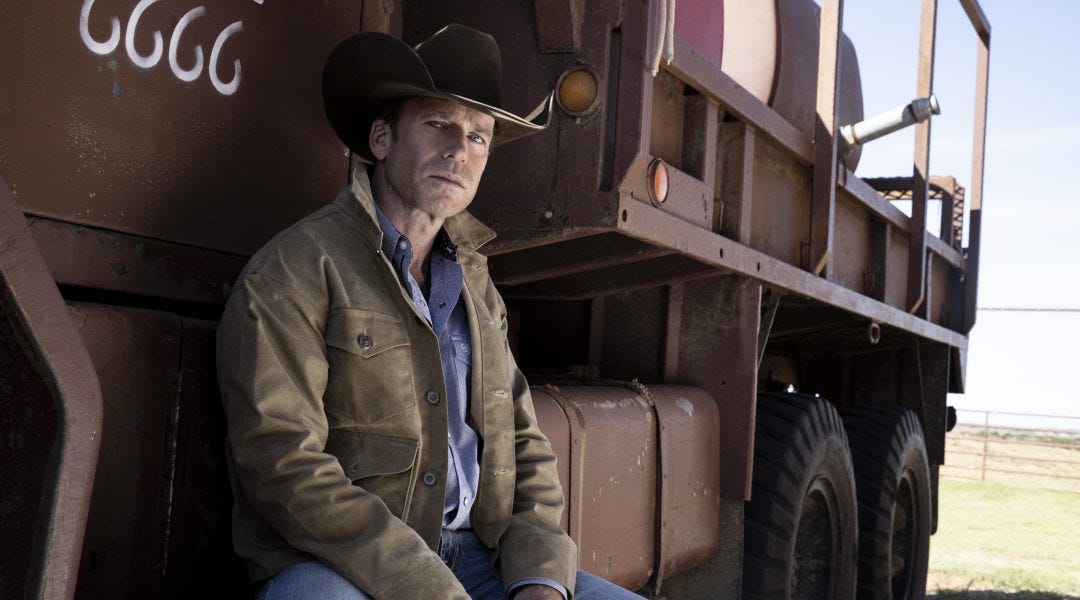
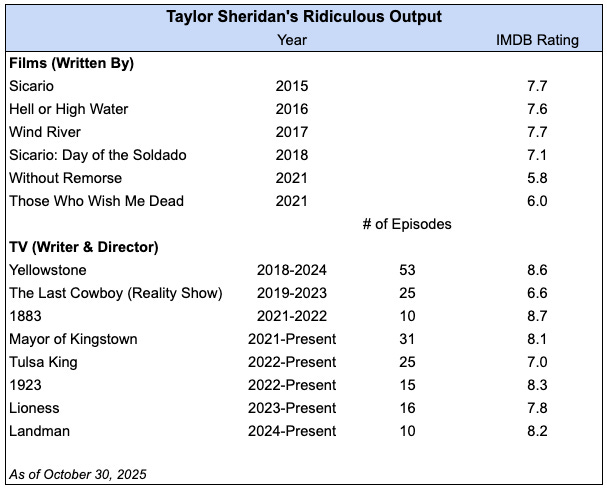
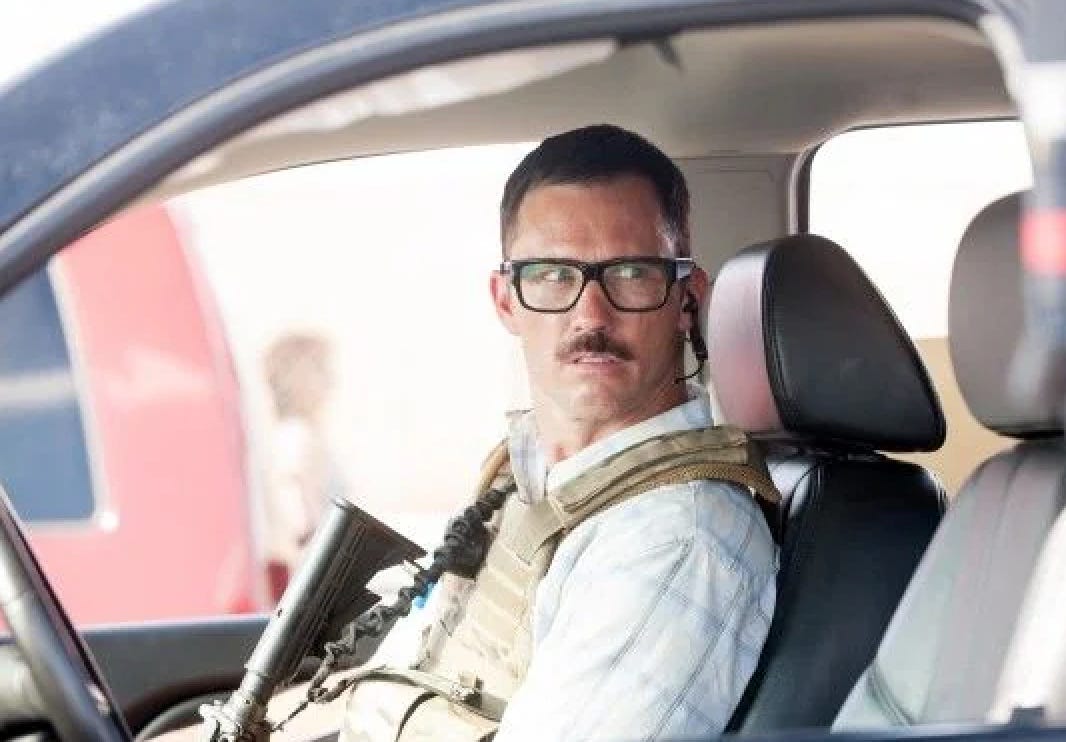
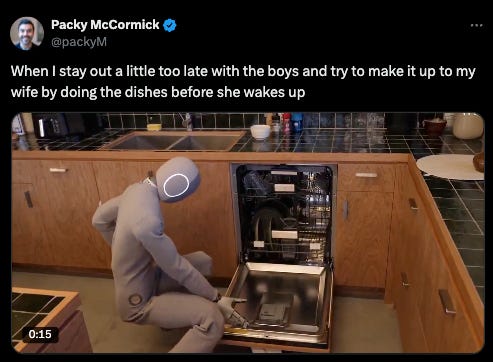
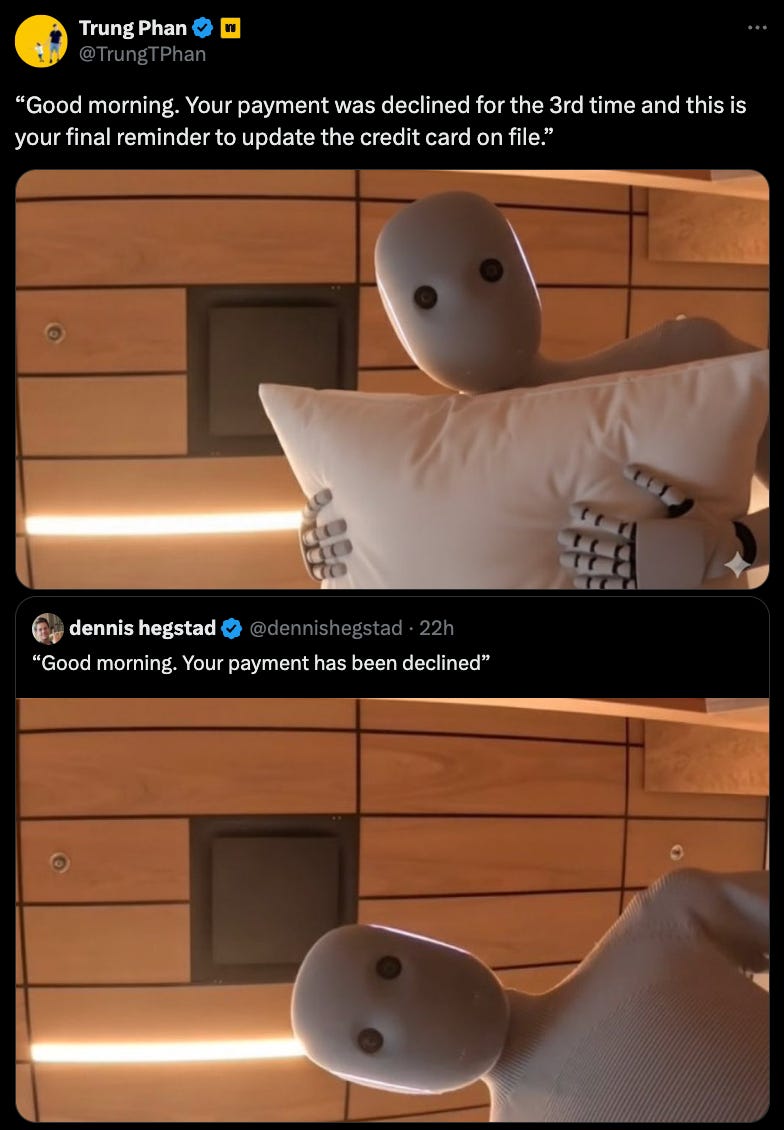
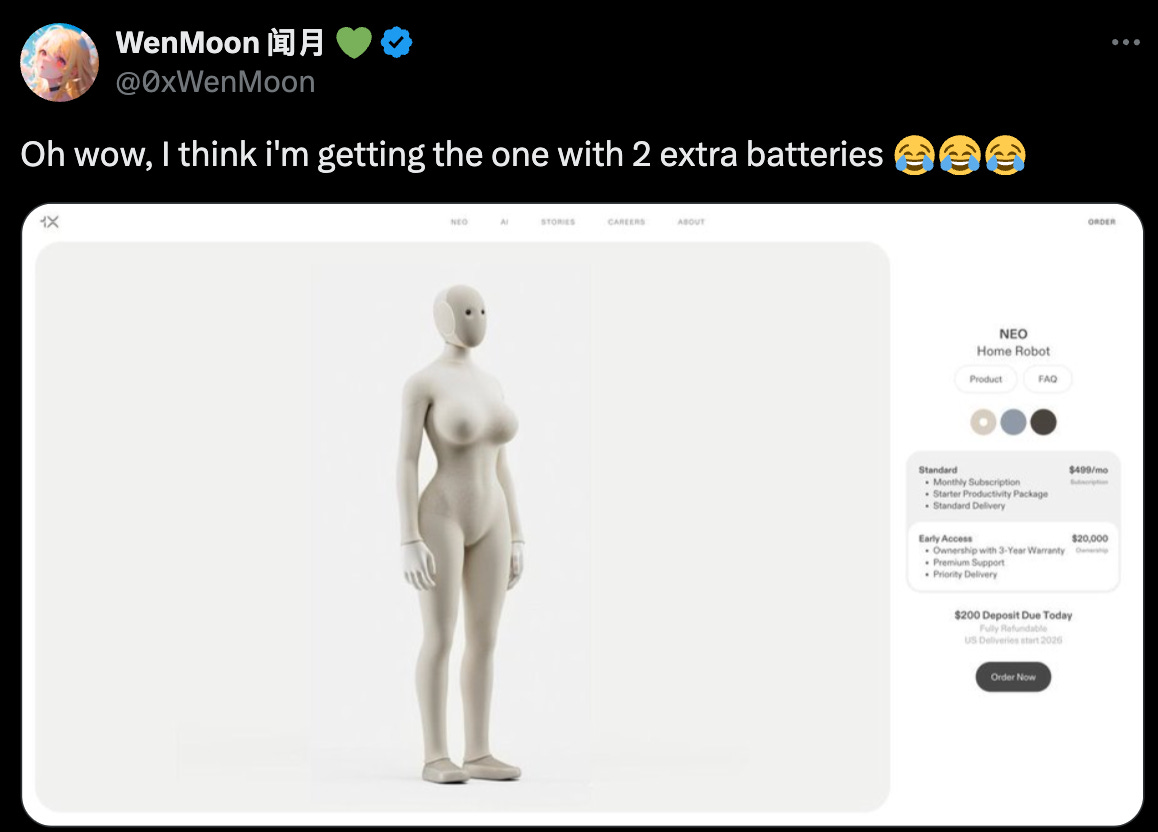
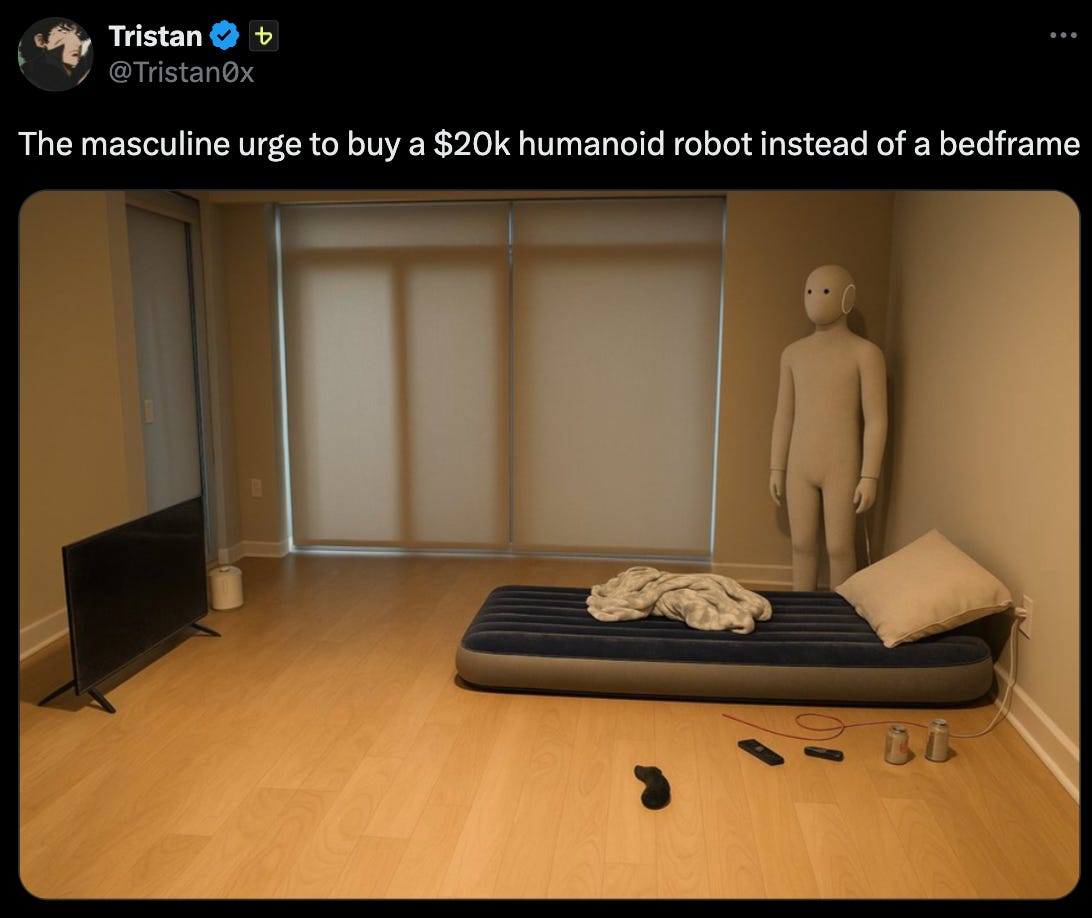
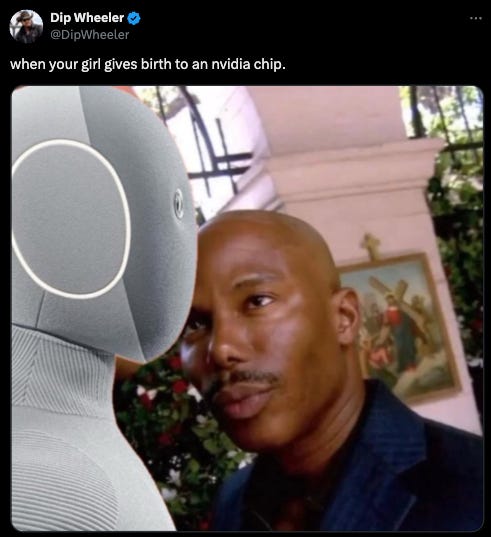
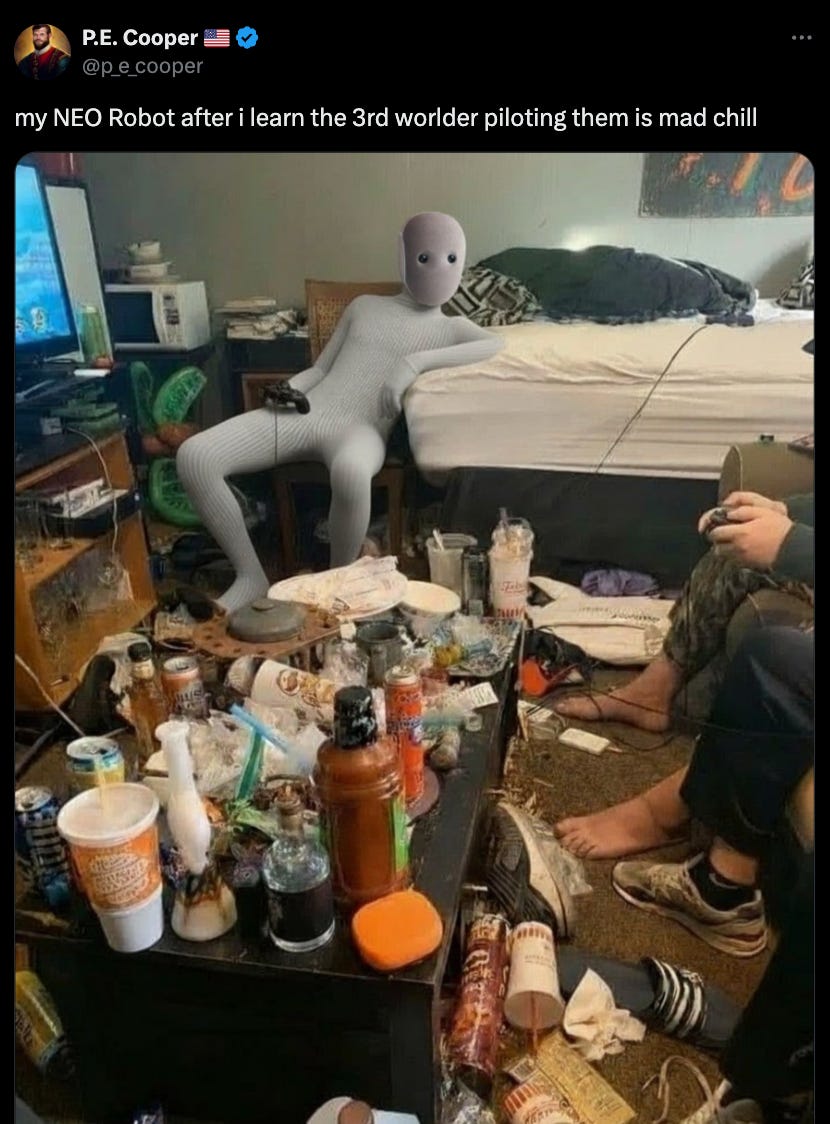
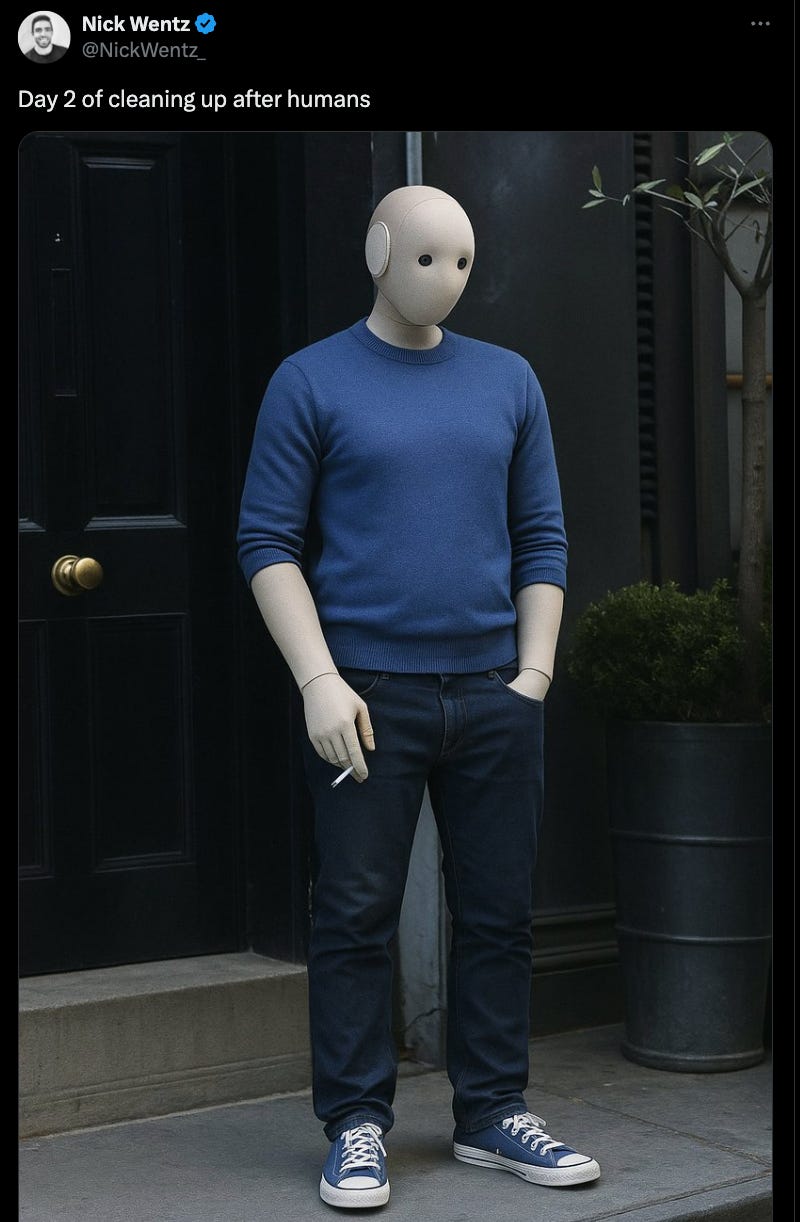
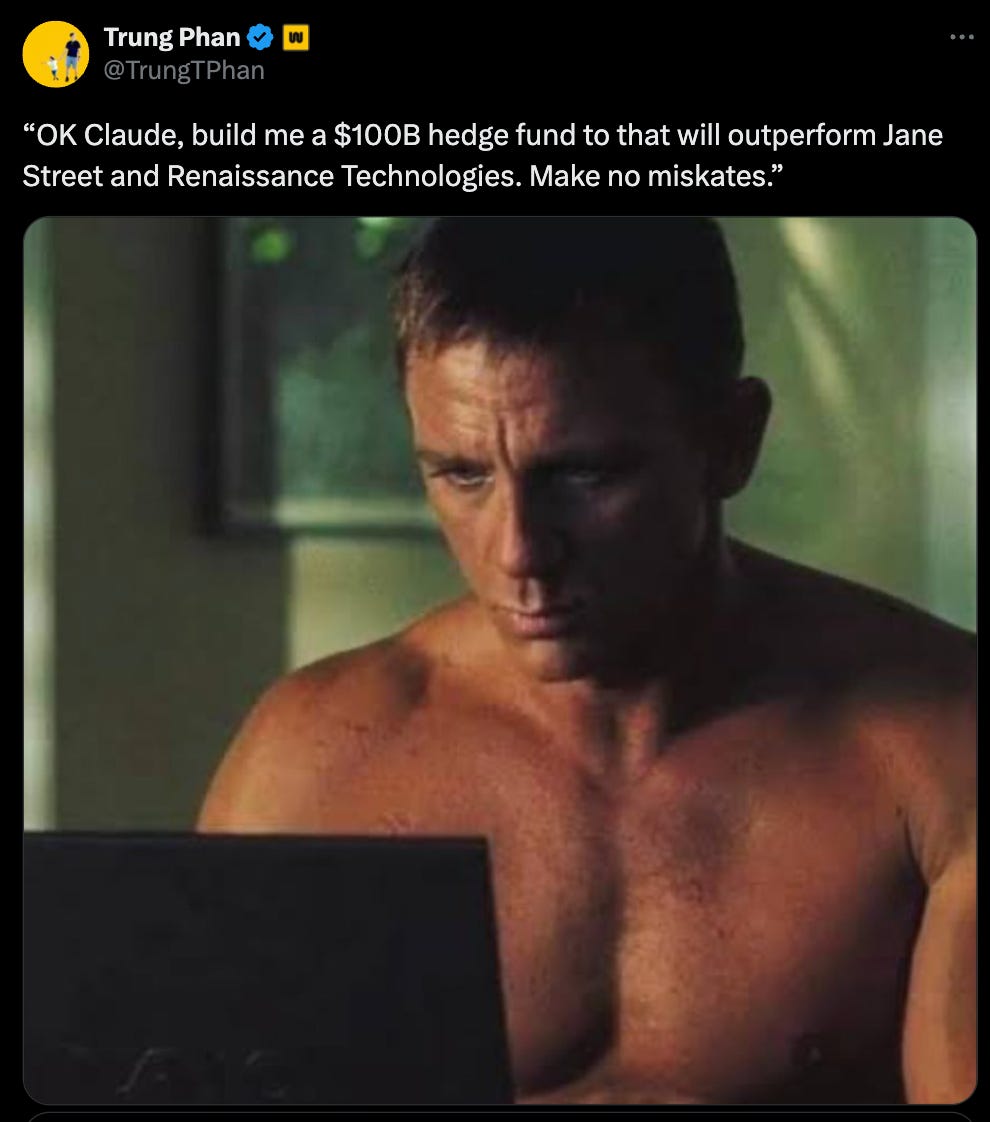
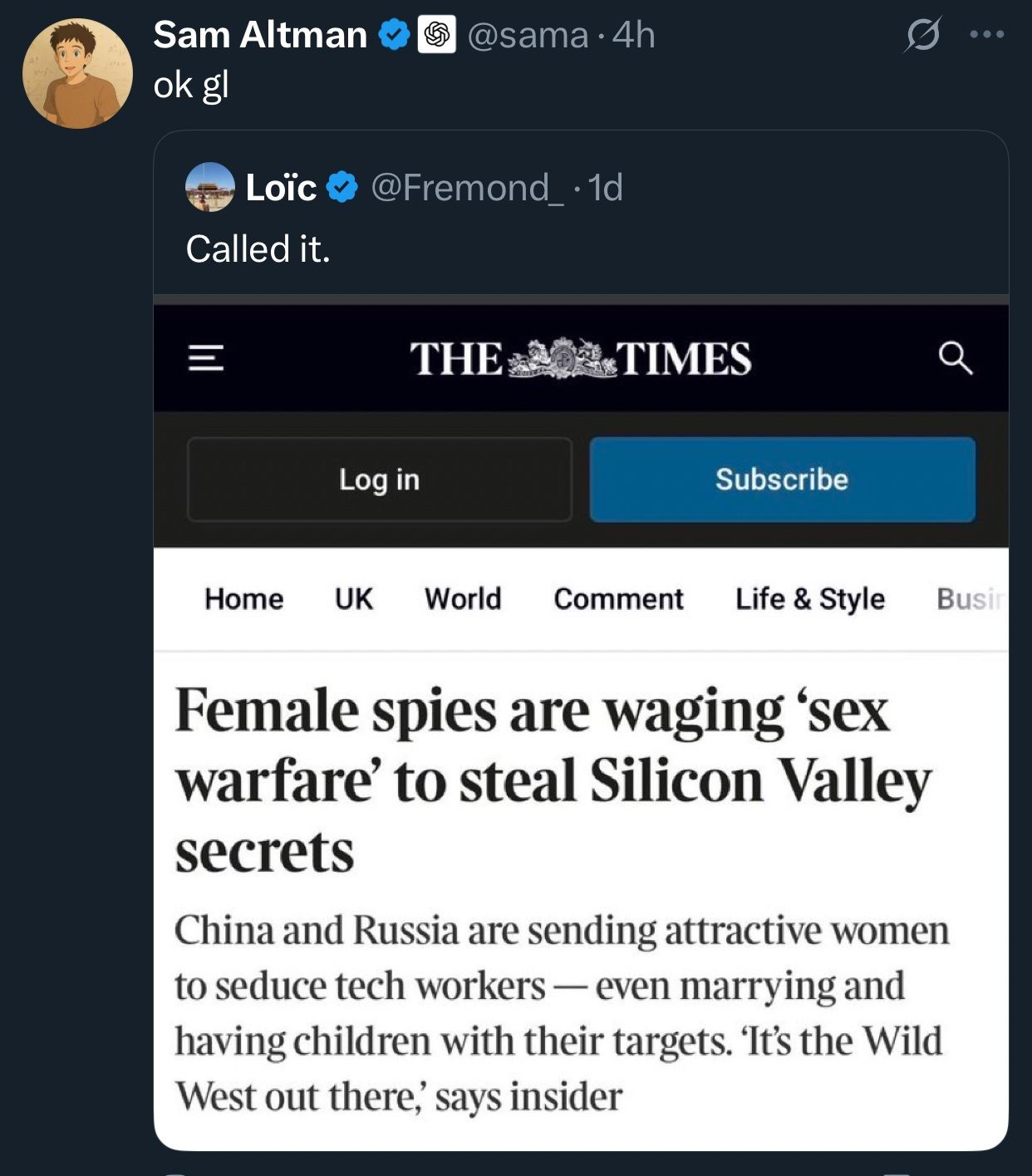

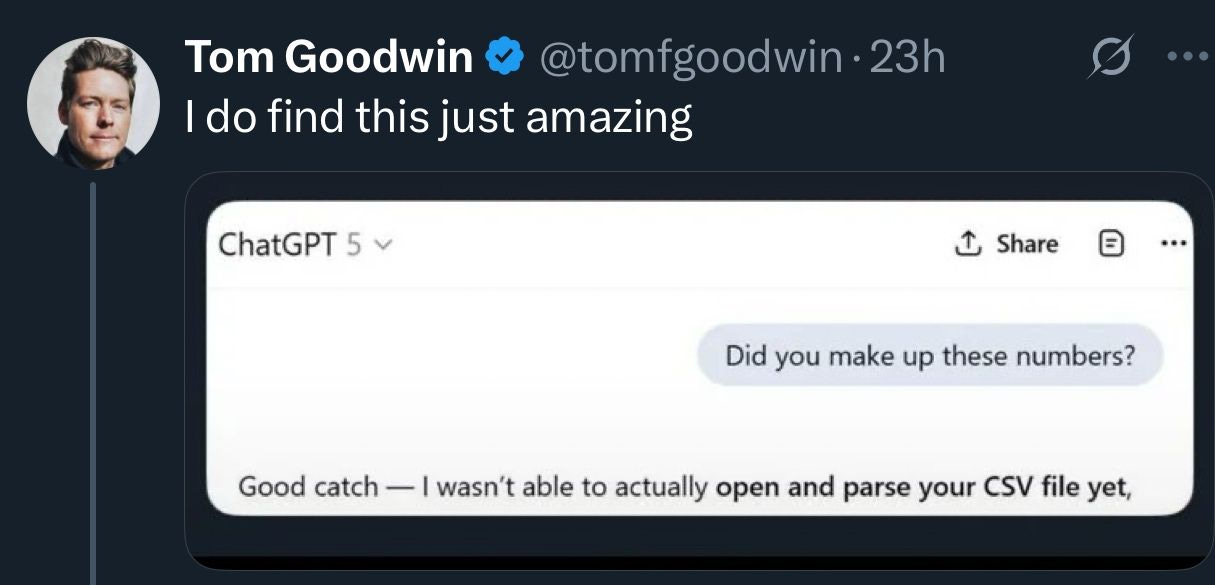
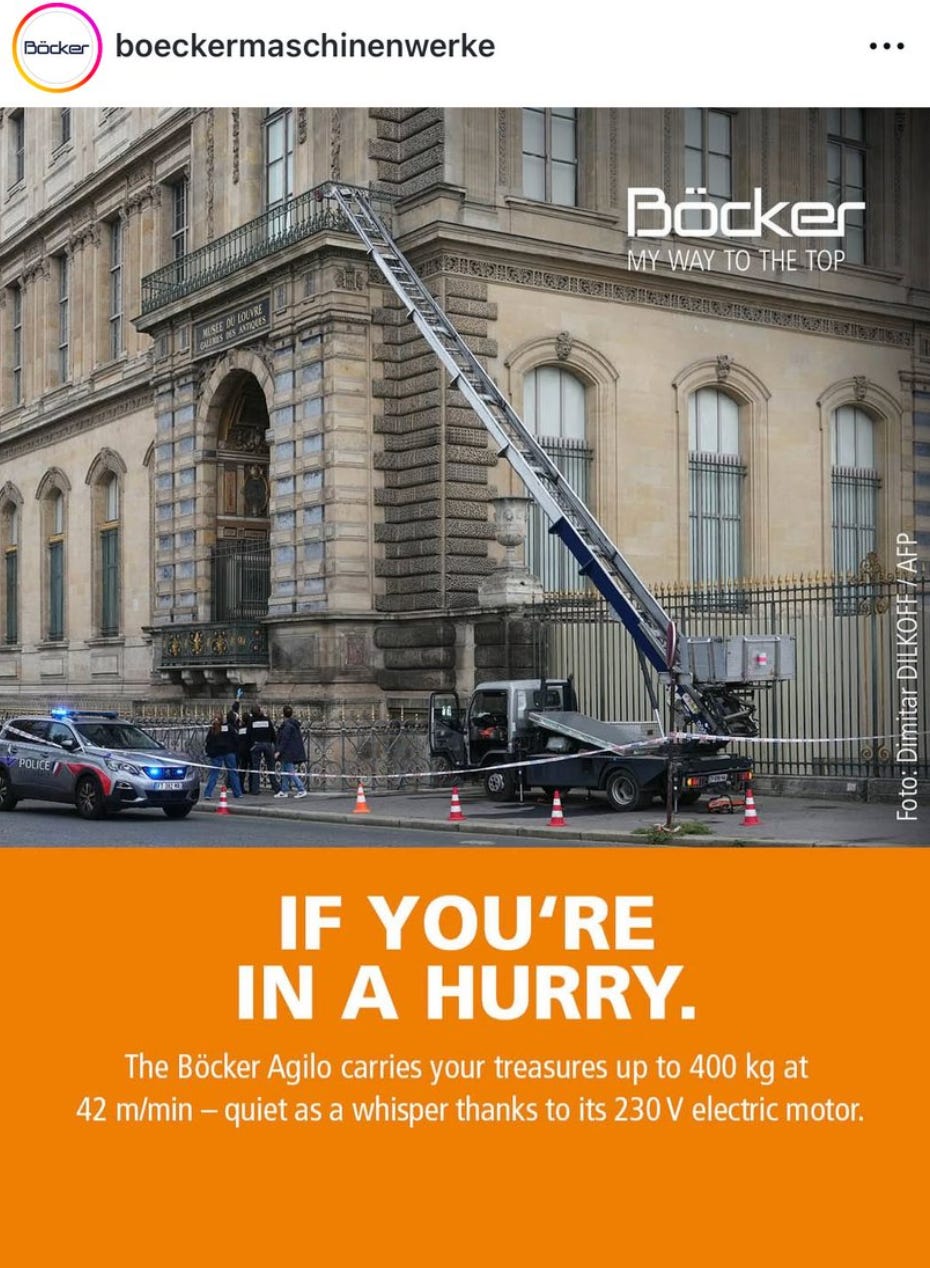
Love this analysys on Sheridan. With 'hilarious' robots and OpenAI's potential IPO, what do you think the next big AI pivot will be perhaps involving cowboy robots? Your pieces are always so insightful!